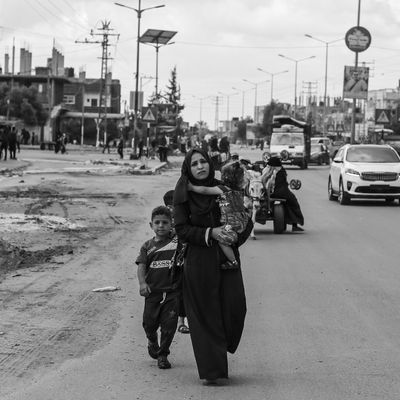
On Sunday, an Israeli airstrike that ignited a fire in a Gaza refugee encampment killed at least 45 people and injured more than 200 others in the southern city of Rafah. Then, on Tuesday, another Israeli attack killed at least 21 people, including 13 women, who were in tents near a field hospital in nearby Al-Mawasi, parts of which Israel had declared as a humanitarian zone. The carnage came just days after the United Nations’ top court ordered Israel to immediately end its military operations on Rafah, citing “immense risk” to the hundreds of thousands of Gazans who’ve been displaced from their homes and sought refuge in the city.
Scott Paul, the associate director of peace and security at Oxfam America, works to end inequality in conflict zones and areas experiencing humanitarian crises, including Gaza. According to the United Nations Relief and Works Agency (UNRWA), more than 1 million people have fled Rafah since Israel first launched its offensive on the city on May 6; Paul says the ongoing bombardment has left those people with virtually no safe place to turn. I spoke with Paul about the deteriorating conditions in Rafah, the continued insecurity displaced Gazans are facing, and how this week’s deadly strikes have worsened an already severe humanitarian crisis.
Can you describe the conditions that people sheltering in Rafah have been dealing with over the past three weeks as Israel launched its offensive there?
Rafah was a city of about 300,000 people, and there have been somewhere between 1.3 and 1.5 million Palestinians taking shelter there. They are there because they were forcibly displaced from their homes elsewhere in Gaza. They made a harrowing journey to get to Rafah in undignified conditions, and finally arrived at a place that was crowded, that was unsanitary, and where basic necessities weren’t sufficiently available, because they were told that this was the last safe place in Gaza. That promise has been violently broken.
What has happened over the past three weeks is that Israel has issued orders for many people to move. Based on prior experience, when people see and understand that bombardment is going to get very fierce, they know not to be anywhere near where they expect the heaviest fighting is going to be. What we’ve seen is the panicked flight of about a million people, the vast majority of whom had already been forced from their homes. They have been moving as quickly as they can, with very little and in impossible circumstances, to try to find a greater measure of safety. They have moved to places with even less support than they had in Rafah. People are finding there wasn’t enough food to eat; there weren’t any latrines available; there wasn’t any clean water.
I have colleagues who were in these panicked mass migrations, where they were jumping to avoid piles of human waste and rivers of sewage running down the street. It’s worth bearing in mind that the people who are moving are people who have been weakened over the past eight months by not having enough food and by being exposed to waterborne diseases. Many of these folks are severely malnourished, and many of them are injured from bombardment.
A lot of extremely disturbing images have been circulating from the aftermath of Sunday’s airstrike on Rafah showing charred bodies and a decapitated child. Eyewitnesses have described the fire spreading through the tent camp as terrifying. What have you heard from people on the ground?
People are terrified. When these kinds of military operations intensify, not only is no one safe, but people’s basic humanity appears to be in question. That seems to be the cumulative effect of these horrific attacks that we’ve seen over the past 72 hours or so. The fact that they’ve taken place in encampments mostly populated by tents, that children have been among those who have been most visibly and jarringly mutilated — it really shakes everyone to the core. People know that they are vulnerable and that the basic protections that typically safeguard them from the worst of humanity aren’t in place right now.
As you’ve pointed out, reports indicate that more than half of the victims were women, children, and elderly people. We know that women and children have borne the brunt of this conflict over the past eight months. What are their most pressing needs at this stage?
First and foremost, they need to be safe. They need to be safe from bombardment, and they need to be safe from the unexploded ordnance that’s now all over the Gaza Strip. Young people, of course, need education. But much more urgently, what they need is treatment for severe acute malnutrition that many people are experiencing, access to clean and safe water, and access to sanitation services. People in Gaza are either experiencing famine or they’re right on famine’s doorstep. In these situations, it’s not as if you eat a delicious, filling meal and everything’s better. You need intensive medical intervention to help bring you back. You need to be able to recover somewhere where there’s safe water, someplace that’s clean. Those circumstances don’t exist anywhere in Gaza right now.
You mentioned that a lot of people have left Rafah. Israel had previously ordered Gazans who were under attack in other parts of the territory to flee there. Then this month, Israel once again ordered those displaced to leave for safer areas by the coast. Now, one of those evacuation zones has been hit. For those who can leave Rafah, is anywhere safe? Where do they go?
It just doesn’t seem that way. There is nowhere safe. People who are able have clearly made the choice to leave large parts, if not all, of Rafah. That does not mean that they’re safe elsewhere and the history of the past eight months proves that they aren’t. The history of the past three days proves that they aren’t. And not everyone has the capacity to move. We’re talking about people who are at this point enfeebled by malnutrition, people who are injured. We have amputees who have mobility challenges. They’ve been shuffled around like a human deck of cards for the past eight months on the expectation that they can just pick up and move their entire lives elsewhere at a moment’s notice.
What about those people who cannot leave? What are your concerns for those who are continuing to shelter in Rafah right now?
They need to be protected. They are at the heart of some of the most fierce and intense military operations that have taken place this century. They’re also unable to access basic services. All of this comes back to one basic and unavoidable truth: The only way to protect any of the 2.2 million people in the Gaza Strip right now, not just from violence but from malnutrition and waterborne disease, is a cease-fire. It is the only way to scale up a humanitarian response, mitigate or prevent famine, and facilitate the return of the remaining Israeli hostages in the custody of Hamas.
Oxfam recently published a report about the coming epidemic of disease in Gaza. How do the latest strikes worsen the situation?
We looked holistically at the infrastructure and services that enable the provision of basic water and sanitation to the population. We found that the water and sanitation networks have been really crippled — either fully destroyed or damaged past the point of functioning. You add to that the fact that electricity is unavailable and fuel is unavailable. You have about $210 million of damage to infrastructure. That’s largely above ground, not including below-ground damage, which we suspect is much more extensive. Without fuel or electricity, you can’t run water wells, you can’t run desalination plants, you can’t treat wastewater, and you can’t move sewage from the streets. All of that together leads to this overwhelming public-health crisis that’s unfolding in the thick of the summer heat — the conditions most conducive to the spread of epidemics.
This is the time when you need to invest in providing those basic services in an environment where humanitarian agencies can not just bring humanitarian assistance into Gaza but also freely access the population. Exactly the opposite is taking place. Almost no assistance is entering Gaza, and the commodities and assistance that are inside of Gaza are almost impossible to move, either because they’re being restricted by order of the Israeli military or because security conditions simply don’t allow it.
It really does start with a cease-fire. We can bring in 100 trucks, 300 trucks, or 500 trucks. But if we aren’t in a position where we can scale up the provision of clean and safe water, if we can’t invest in the kind of intensive medical interventions that are needed to deal with severe acute malnutrition, if we don’t have the fuel to operate water wells and desalination plants, it’s gonna be impossible to pull back from the brink.
This interview has been edited and condensed for length and clarity.


